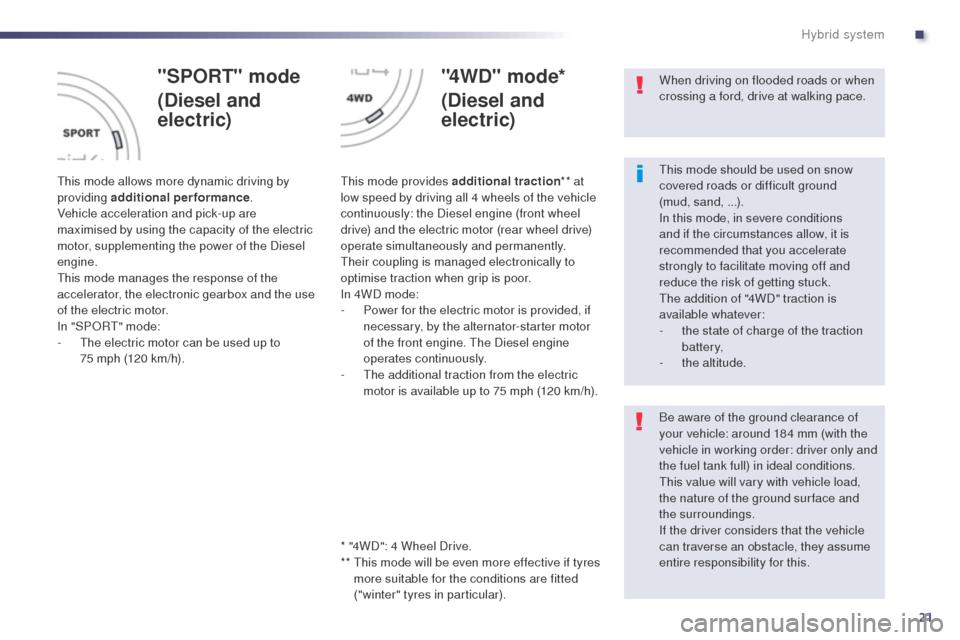Page 22 of 338

20
508RXH_en_Chap00c_systeme-hybride_ed01-2014
"AUTO" mode
It automatically manages the operation of the
Diesel engine and the electric motor, according
to vehicle parameters, traffic conditions and
driving style so as to optimise the vehicle's
fuel consumption.
th
is mode activates "zero emissions"
electric running when the conditions allow.
In "A
u
t
O
" mode, the electric motor :
-
c
an power the vehicle on its own in "zero
emissions" electric running, depending
on the state of charge of the battery, if the
conditions specific to the vehicle are met
and if acceleration is moderate,
-
s
upplements the Diesel engine when
moving off and changing gear, during
acceleration and when traction from the
front wheels is inadequate (it automatically
adds 4 wheel drive ),
-
C
an be active alone up to 53 mph (85 km/h).
I
t is no longer active above 75 mph (120 km/h).
"ZEV" mode
(all electric)
"Zero emissions vehicle" operation is assured
100 % by electric drive.
th
is mode forces silent running at moderate
speeds. If the conditions do not allow this mode,
the message "electric mode is not currently
available" appears in the screen.
t
h
e Z
eV
w
arning lamp flashes for a few seconds then
goes off and the selector comes on in "A
u
t
O
".
In "Z
eV
" mode:
-
R
ange and acceleration capacity are
limited.
t
h
e maximum speed is around
36 mph (60 km/h).
-
u
n
der high load or a priority requirement
causing the start of the Diesel engine, the
system changes automatically to A
u
t
O
m
ode.us
e in preference
for everyday driving
and optimised fuel consumption.
Activated automatically when starting
the HYbrid4 system.
For more information on the factors
for automatic restarting of the
Diesel engine and when there is NO
access to "Z
eV
" mode", refer to the
corresponding section.
It can be activated when the
required conditions are met,
particularly if the state of
charge of high voltage battery is
sufficient (from 4 bars).
Hybrid system
Page 23 of 338

21
508RXH_en_Chap00c_systeme-hybride_ed01-2014
"SPORT" mode
(Diesel and
electric)
this mode allows more dynamic driving by
providing additional performance.
Vehicle acceleration and pick-up are
maximised by using the capacity of the electric
motor, supplementing the power of the Diesel
engine.
th
is mode manages the response of the
accelerator, the electronic gearbox and the use
of the electric motor.
In "SPOR
t" m
ode:
-
t
h
e electric motor can be used up to
75 mph (120 km/h).
"4WD" mode*
(Diesel and
electric)
this mode provides additional traction ** at
low speed by driving all 4 wheels of the vehicle
continuously: the Diesel engine (front wheel
drive) and the electric motor (rear wheel drive)
operate simultaneously and permanently.
th
eir coupling is managed electronically to
optimise traction when grip is poor.
In 4WD mode:
-
P
ower for the electric motor is provided, if
necessary, by the alternator-starter motor
of the front engine.
t
h
e Diesel engine
operates continuously.
-
t
h
e additional traction from the electric
motor is available up to 75 mph (120 km/h).th is mode should be used on snow
covered roads or difficult ground
(mud, sand, ...).
In this mode, in severe conditions
and if the circumstances allow, it is
recommended that you accelerate
strongly to facilitate moving off and
reduce the risk of getting stuck.
th
e addition of "4WD" traction is
available whatever:
-
t
he state of charge of the traction
battery,
-
t
he altitude.
Be aware of the ground clearance of
your vehicle: around 184 mm (with the
vehicle in working order: driver only and
the fuel tank full) in ideal conditions.
th
is value will vary with vehicle load,
the nature of the ground sur face and
the surroundings.
If the driver considers that the vehicle
can traverse an obstacle, they assume
entire responsibility for this.
* "4WD": 4 Wheel Drive.
**
t
h
is mode will be even more effective if tyres
more suitable for the conditions are fitted
("winter" tyres in particular). When driving on flooded roads or when
crossing a ford, drive at walking pace.
.
Hybrid system
Page 223 of 338

221
508RXH_en_Chap08_info-pratiques_ed01-2014
Driving advice
Distribution of loads
F Distribute the load in the trailer so that the heaviest items are as close as possible to
the axle and the nose weight approaches the
maximum permitted without exceeding it.
Air density decreases with altitude, thus
reducing engine performance. Above
1
000 metres, the maximum towed load must
be reduced by 10
% for every 1 000 metres of
altitude.
Side wind
F take into account the increased sensitivity to side wind.
Cooling
towing a trailer on a slope increases the
temperature of the coolant.
As the fan is electrically controlled, its cooling
capacity is not dependent on the engine speed.
F
t
o l
ower the engine speed, reduce your
speed.
th
e maximum towed load on a long incline
depends on the gradient and the ambient
temperature.
In all cases, keep a check on the coolant
temperature.
F
I
f the warning lamp and the STOP
warning lamp come on, stop the
vehicle and switch off the engine
as soon as possible.
Braking
towing a trailer increases the braking distance.to a void overheating of the brakes on a long
mountain type of descent, the use of engine
braking is recommended.
Ty r e s
F Check the tyre pressures of the towing vehicle and of the trailer, observing the
recommended pressures.
Lighting
F Check the electrical lighting and signalling on the trailer.
th
e rear parking sensors will be
deactivated automatically if a genuine
P
e
uge
Ot
towbar is used.
Refer to the "
te
chnical data" section for details
of the weights and towed loads which apply to
your vehicle.
8
Practical information